Soccer, known as football in many parts of the world, is a dynamic and strategic sport characterized by the diverse roles and responsibilities of its players. Understanding soccer positions is fundamental to appreciating the tactical nuances of the game. Each position on the field, from the goalkeeper to the forwards, plays a unique role that contributes to the team’s overall performance and strategy.
What are all the positions in soccer?
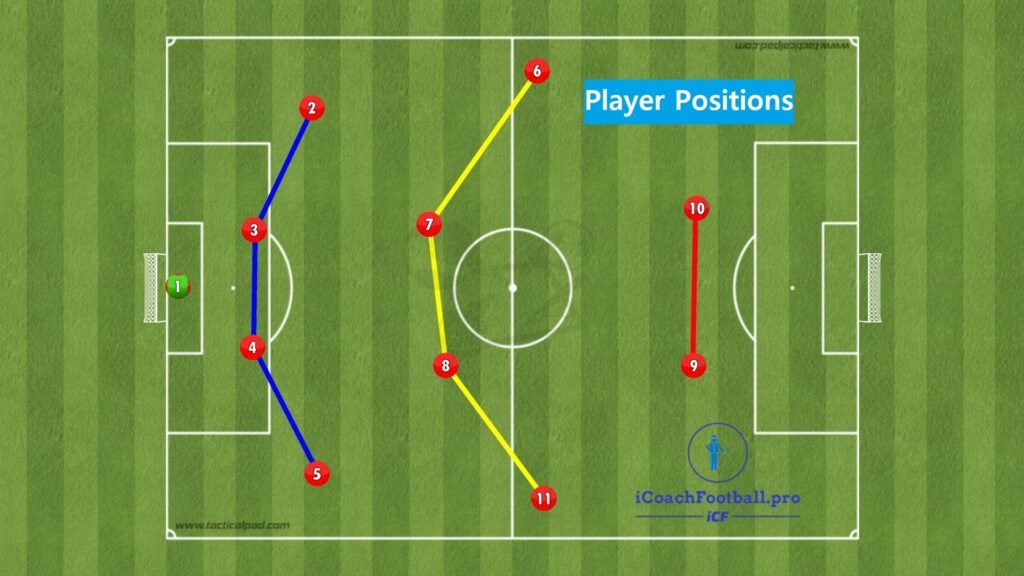
A standard soccer team is composed of eleven players, each assigned to specific positions. These positions can be broadly categorized into four main groups: defenders, midfielders, forwards, and the goalkeeper. Defenders are primarily responsible for preventing the opposing team from scoring, while midfielders act as a bridge between the defense and the offense, often controlling the flow of the game. Forwards, or strikers, are tasked with scoring goals, and the goalkeeper’s primary duty is to guard the net.
In the following sections, we will delve deeper into the specific roles and responsibilities associated with each soccer position, exploring how they contribute to the team’s overall tactics and success on the field.
Goalkeeper: The Last Line of Defense
The goalkeeper holds a pivotal role in soccer, often considered the backbone of the team’s defense. Unlike other football positions, the goalkeeper is tasked with the unique responsibility of preventing the opposing team from scoring by guarding the goal. This position demands a blend of physical agility, mental acuity, and technical proficiency.
One of the primary skills required for a goalkeeper is shot-stopping. This involves quick reflexes and the ability to read the game, allowing the goalkeeper to anticipate the direction and speed of shots. Effective shot-stopping can turn the tide of a match, making the goalkeeper an essential asset during high-pressure situations.
Equally important is the goalkeeper’s distribution ability. After securing the ball, a goalkeeper must quickly and accurately distribute it to teammates to initiate counter-attacks. Whether through throws, kicks, or rolling the ball, efficient distribution can exploit gaps in the opposition’s formation and create scoring opportunities for the team.
Commanding the penalty area is another crucial aspect of the goalkeeper’s role. This includes catching or punching away crosses, organizing the defense during set-pieces, and making decisive sweeper-keeper interventions when necessary. Effective communication with the defenders is vital, ensuring that the team maintains its defensive structure and minimizes vulnerabilities.
In addition to these responsibilities, the goalkeeper also plays a strategic role in organizing the defense. By maintaining a clear view of the entire field, the goalkeeper can direct defenders to cover specific areas, mark opposing players, and adjust their positioning based on the flow of the game. This organizational ability not only fortifies the defense but also provides a solid foundation for the team to build attacks.
The importance of the goalkeeper extends beyond mere shot-stopping. Their multifaceted role encompasses a range of skills that are integral to both defensive solidity and attacking prowess, making them an indispensable component of any soccer team.
Defenders: The Backbone of Defense
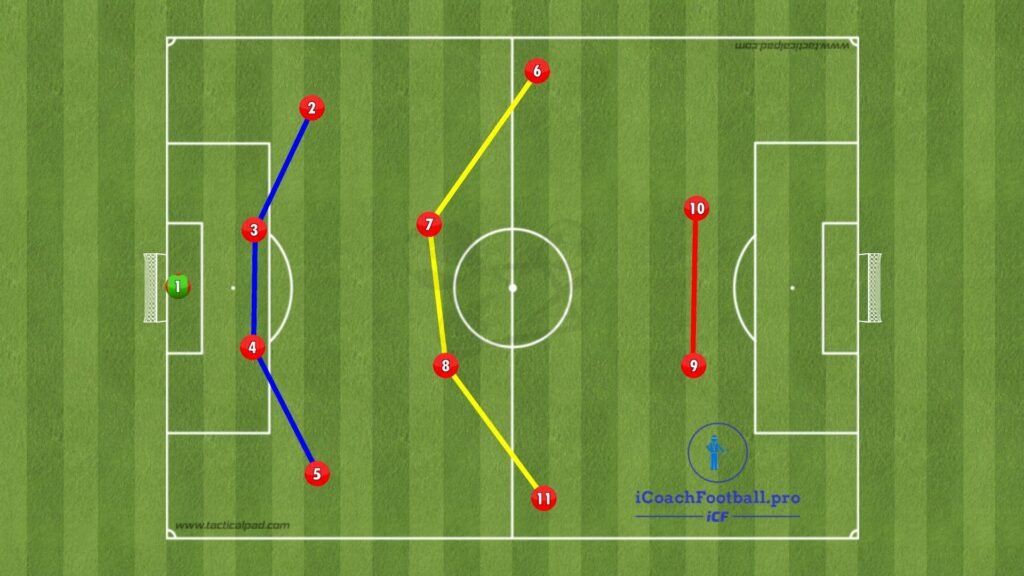
The Blue Line
Defenders play a crucial role in the structure of soccer positions, serving as the backbone of the team’s defense. Among the primary types of defenders are center-backs, full-backs, and wing-backs, each with distinct responsibilities that contribute to the overall defensive strategy.
Center-backs are central to the defense, tasked with marking the opposition’s strikers and intercepting attacks. Their positioning is fundamental, as they must maintain a strategic line to prevent through balls and counterattacks. Effective center-backs combine physical strength with tactical awareness, excelling in tackles and aerial duels to clear the ball from dangerous areas.
Full-backs, positioned on either side of the defense, have the dual responsibility of thwarting opposition wingers and supporting their own team’s offensive play. They need to be adept at one-on-one defending and quick to track back when out of possession.
Full-backs are often involved in initiating attacks, making overlapping runs to provide width and deliver crosses into the opposition’s penalty area. Their stamina, speed, and defensive acumen are critical to balancing their defensive and offensive duties.
Wing-backs, a more modern adaptation of the full-back role, operate similarly but with a greater emphasis on attacking contribution. Often employed in formations with three center-backs, wing-backs have the freedom to advance further up the field, acting almost as midfielders in offensive phases. This position requires exceptional endurance and versatility, as wing-backs must transition quickly between defense and attack, contributing both to stopping opponents and creating scoring opportunities.
The effectiveness of defenders in these soccer positions is heavily dependent on their ability to read the game, make timely tackles, and win aerial battles. Their positioning on the field is paramount; a well-organized defense can disrupt the opposition’s rhythm and significantly reduce goal-scoring chances. By mastering these elements, defenders lay the groundwork for a solid defense, ensuring their team remains competitive in every match.
Midfielders: The Engine Room

The Yellow Line
The role of midfielders in soccer is multifaceted and vital to a team’s overall performance. Often referred to as the “engine room,” midfielders are responsible for linking defense and attack, controlling the tempo of the game, and providing both defensive cover and offensive support. There are various types of midfielders, each with specific roles and responsibilities that contribute to the team’s strategy and success.
Defensive midfielders, also known as holding midfielders, primarily focus on breaking up opposition plays and protecting the defense. They are adept at intercepting passes, making crucial tackles, and maintaining positional discipline. Their role is pivotal in shielding the backline and providing a platform for more creative players to operate. Key skills for a defensive midfielder include strong tackling, positional awareness, and the ability to read the game effectively.
Central midfielders, or box-to-box midfielders, have a broader range of responsibilities. They are involved in both defensive and offensive duties, covering large areas of the pitch. Central midfielders are required to have excellent stamina, as they need to contribute to defensive efforts while also supporting attacks. Their role often includes distributing the ball efficiently, maintaining possession, and linking up with both the defense and attack. Skills such as passing accuracy, vision, and endurance are crucial for central midfielders.
Attacking midfielders, on the other hand, focus primarily on creating goal-scoring opportunities. They operate closer to the opponent’s goal and are often the team’s main playmakers. Attacking midfielders need to have exceptional dribbling skills, creativity, and the ability to make incisive passes that can break down defenses. Their responsibilities include assisting forwards, scoring goals, and maintaining a high level of offensive pressure on the opposition.
In summary, midfielders play a critical role in what are the positions in soccer by balancing defensive and offensive duties. Their ability to control the game’s tempo, provide defensive cover, and support attacks makes them indispensable to any team. Understanding the different types of midfielders and their specific skill sets is essential for appreciating the complexities of soccer positions.
Forwards: The Goal Scorers

The Red Line
Forwards play a pivotal role in any soccer team, primarily tasked with scoring goals and creating scoring opportunities. Among the various soccer positions, forwards are often the most celebrated, given their direct contribution to the game’s ultimate objective—putting the ball into the back of the net.
Strikers, also known as center forwards, are typically positioned closest to the opponent’s goal. Their primary responsibility is to finish scoring chances. They must possess exceptional finishing skills, enabling them to convert opportunities into goals, often under immense pressure from defenders and goalkeepers. Moreover, strikers need to have a keen sense of positioning, allowing them to find and exploit gaps in the defensive line.
Wingers, or wide forwards, operate along the flanks of the pitch. Their role extends beyond scoring; they are also instrumental in creating goal-scoring opportunities for their teammates. Wingers rely heavily on speed and dribbling skills to beat defenders and deliver accurate crosses into the penalty area. Their ability to stretch the defense wide opens up space for other attackers, making them crucial in both direct and indirect goal creation.
Second strikers, or supporting forwards, play a versatile role, often positioned just behind the main striker. They link the midfield and the attack, contributing to both the build-up play and finishing moves. Second strikers require excellent off-the-ball movement, enabling them to find space between the opposition’s defensive and midfield lines. Their dribbling prowess and vision are essential for creating scoring opportunities, both for themselves and their teammates.
All these football positions demand specific skills and attributes. Finishing, speed, dribbling, and intelligent off-the-ball movement are indispensable for forwards. These abilities not only help in scoring goals but also in maintaining pressure on the opposition and creating a dynamic attacking presence. Understanding the nuances of these roles provides valuable insights into what are the positions in soccer and their respective contributions to the team’s success.
Player Positions in Popular Formations, Roles and Responsibilities
The arrangement of these players on the field is referred to as a formation. Formations are strategic frameworks that dictate how players are positioned and how they interact during the game.
Common formations include the 4-4-2, 4-3-3, and 3-5-2, among others. Each formation has its own strengths and weaknesses, and coaches often choose formations based on the team’s strengths, the opponent’s tactics, and the specific demands of the match.
The significance of soccer positions is highlighted by the roles assigned to each player within these formations. For example, in a 4-3-3 formation, the emphasis might be on a strong attacking presence with three forwards, supported by a balanced midfield and a solid defensive line.
Conversely, a 4-4-2 formation might focus on a more balanced approach with two forwards and a robust midfield presence. Understanding these positions and formations is crucial for both players and spectators, as it enhances the appreciation of the game’s strategic depth.
Positions in 4-2-3-1 Formation
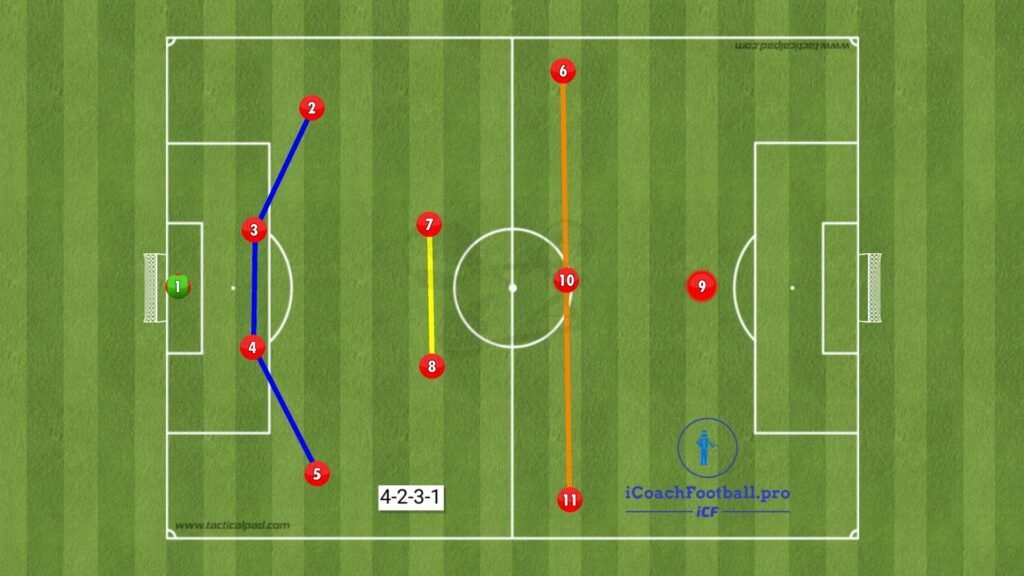
The 4-2-3-1 formation is renowned for its balance and flexibility, making it one of the most popular setups in modern soccer. This formation features four defenders, two defensive midfielders (often referred to as the “double pivot”), three attacking midfielders, and a lone striker. Each position in this formation has distinct responsibilities that contribute to both defensive solidity and offensive fluidity.
The back four in the 4-2-3-1 formation consists of two center-backs and two full-backs. The center-backs are tasked with marking the opposition’s forwards and preventing goal-scoring opportunities, while the full-backs have dual roles: they must defend against wingers and also support attacking plays by providing width and delivering crosses into the opponent’s penalty area.
The double pivot, composed of two defensive midfielders, is crucial for maintaining stability. These players shield the back four, intercept passes, and break up opposition attacks. Additionally, they serve as the link between defense and attack, distributing the ball to more advanced teammates and occasionally joining the offensive efforts.
In front of the double pivot are the three attacking midfielders, who are typically aligned as one central attacking midfielder flanked by two wide players. The central attacking midfielder is often the playmaker, orchestrating the team’s offensive moves and creating scoring opportunities. The wide attacking midfielders, or wingers, are responsible for stretching the opponent’s defense, delivering crosses, and cutting inside to take shots or set up teammates.
At the forefront of the 4-2-3-1 formation is the lone striker. This player’s primary role is to score goals, but they also need to hold up the ball, bring others into play, and press the opposition’s defenders when not in possession. The lone striker must be versatile, capable of finishing chances and contributing to the team’s overall play.
Overall, the 4-2-3-1 formation offers a balanced approach to soccer, blending defensive robustness with attacking creativity. Its structure allows for fluid transitions between defense and attack, making it a favored choice for many teams seeking to dominate both ends of the pitch.
Positions in 4-3-3 formation
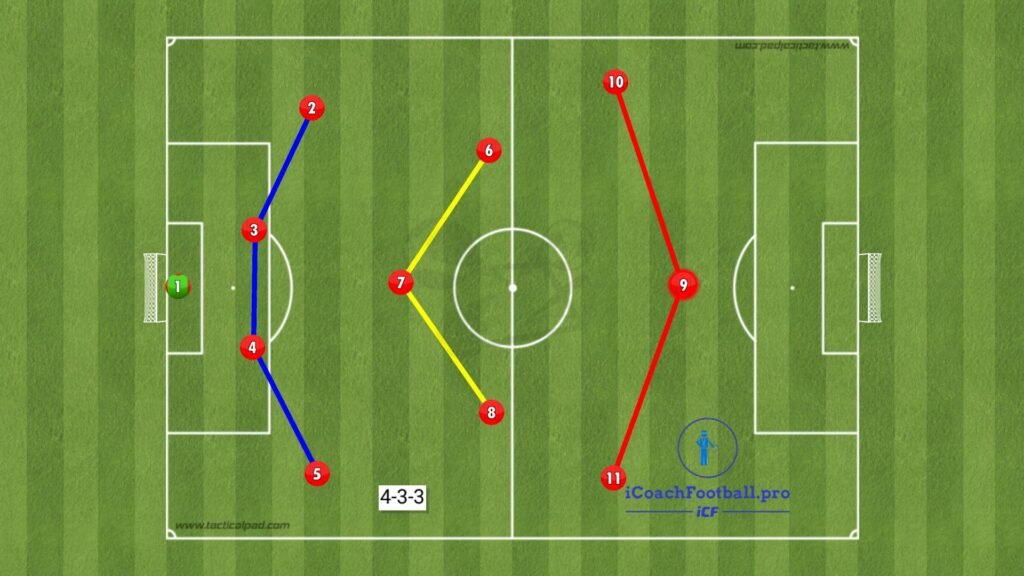
The 4-3-3 formation is a dynamic and versatile setup that prioritizes attacking potential and possession. This soccer formation is distinguished by its three forwards, three midfielders, and four defenders, each with specific roles and responsibilities that contribute to the team’s overall strategy.
In the 4-3-3 formation, the three forwards typically consist of a central striker flanked by two wingers. The striker’s primary role is to convert opportunities into goals, leveraging speed and positioning to outmaneuver defenders.
The wingers provide width, stretching the opposition’s defense and creating space for themselves and their teammates. They are crucial in delivering crosses into the box, taking on defenders one-on-one, and cutting inside to shoot.
The midfield trio in this formation plays a pivotal role in maintaining possession and dictating the pace of the game. Usually composed of a central midfielder and two central midfielders, each player has distinct responsibilities. The central midfielder, often referred to as the ‘playmaker’ or ‘regista,’ is essential for orchestrating play, distributing the ball efficiently, and linking defense with attack.
The other two midfielders support both defense and offense, providing balance and stability. They are tasked with winning back possession, supporting the forwards in attack, and shielding the defense.
Full-backs in the 4-3-3 formation are vital for providing width and support in both defensive and offensive phases. Their responsibilities extend beyond traditional defensive duties; they often join the attack, overlapping with wingers to deliver crosses and create additional passing options. This dual role requires them to have high levels of stamina and positional awareness.
The 4-3-3 formation’s emphasis on width and possession makes it a popular choice for teams that prioritize attacking football. By effectively utilizing the roles and responsibilities of each player, this formation can overwhelm opponents and dominate the flow of the game. Understanding the intricacies of soccer positions within this setup is crucial for maximizing its potential and achieving success on the field.
Positions in 4-4-2 Formation
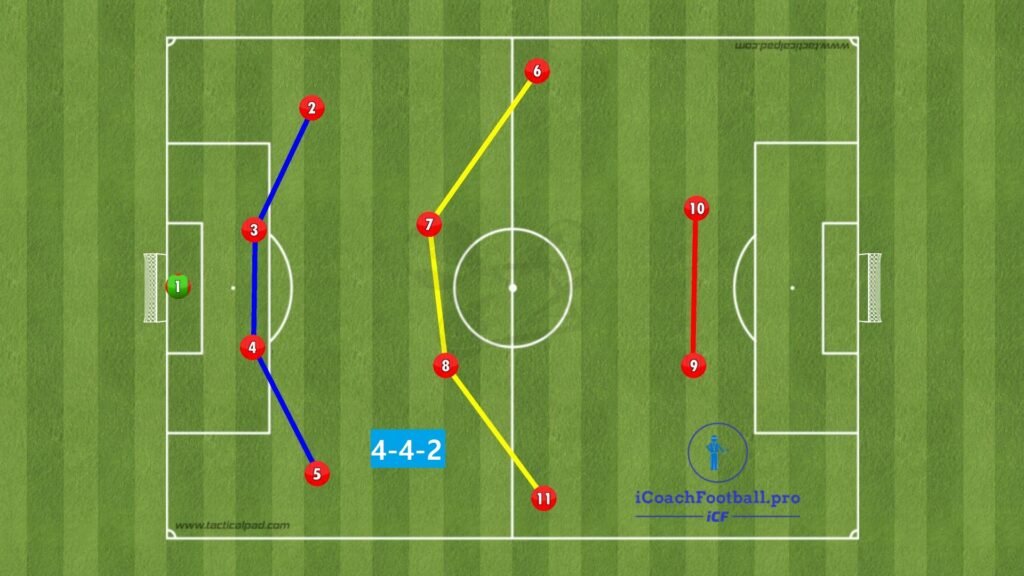
The 4-4-2 formation is one of the most traditional and straightforward setups in soccer. It consists of four defenders, four midfielders, and two forwards, which creates a balanced and flexible approach to both defense and attack. This formation is renowned for its simplicity and structure, making it an enduring choice for many teams.
The defensive solidity of the 4-4-2 formation is derived from its two banks of four players. The back four typically includes two center-backs and two full-backs. The center-backs are primarily responsible for marking the opposition’s forwards and clearing aerial threats. The full-backs, while defending against wingers, often have the dual role of supporting the attack by overlapping with the midfielders.
In the midfield, the four players are usually divided into two central midfielders and two wingers. The central midfielders are crucial for both defensive coverage and initiating attacks. They often act as the engine room of the team, breaking up opposition plays and distributing the ball to the flanks or forwards.
The wingers, on the other hand, are tasked with providing width to the team’s play. They stretch the opposition’s defense by staying wide and delivering crosses into the penalty area, thereby creating scoring opportunities for the forwards.
The two forwards in the 4-4-2 formation work in tandem to break down the opposition’s defense. Typically, one forward plays as a target man, holding up the ball and bringing others into play, while the other operates as a more nimble, pacey striker looking to exploit gaps behind the defense. Their partnership is vital for converting the team’s build-up play into goals.
Overall, the 4-4-2 formation’s clear delineation of roles makes it an effective strategy for many teams. By combining defensive solidity with offensive flexibility, it allows players to understand their responsibilities clearly, fostering teamwork and cohesion on the field.
Player Positions in a 3-5-2 Formation

The 3-5-2 formation is a versatile and strategic setup that can provide teams with both defensive solidity and attacking dynamism. This formation is characterized by three central defenders, five midfielders—including two wing-backs—and two forwards, creating a balanced structure that can adapt to various in-game scenarios.
The three central defenders in this configuration play a crucial role in maintaining a robust defense. Typically, these players consist of a central defender flanked by two stoppers. The central defender acts as the anchor, organizing the backline and stepping up to intercept passes, while the stoppers cover the flanks, providing support to the wing-backs and preventing opposition wingers from exploiting wide areas.
Wing-backs are pivotal in the 3-5-2 formation, as they are responsible for providing width both defensively and offensively. Unlike traditional full-backs, wing-backs in this system are expected to cover extensive ground, contributing to the attack by delivering crosses into the box and tracking back to support the defense. Their dual role demands high levels of stamina and tactical awareness.
The midfield trio in a 3-5-2 formation usually consists of one defensive midfielder and two central midfielders. The defensive midfielder offers protection to the backline, breaking up opposition play and distributing the ball to initiate attacks.
The central midfielders, often referred to as box-to-box players, are tasked with maintaining balance in the midfield, supporting both the defense and the attack. Their ability to transition quickly from defense to offense is vital for the success of this formation.
Upfront, the two forwards in a 3-5-2 formation work in tandem to stretch the opposition’s defense and create goal-scoring opportunities. One forward often plays as a target man, holding up the ball and linking play with the midfield, while the other forward exploits spaces and makes incisive runs behind the defense.
The 3-5-2 formation has been effectively utilized by several professional soccer teams, showcasing its potential to balance defensive stability with attacking prowess. For example, Antonio Conte’s Chelsea during the 2016-2017 Premier League season demonstrated the effectiveness of this setup, winning the league title.
Also Inter Milan did this year (2023-2024 season) won the Seria A Tittle using 3-5-2 formation.
Understanding the roles and responsibilities of different soccer positions is essential for both players and coaches. Each position has unique requirements and contributes to the team’s overall performance in distinct ways. Whether in the attacking phase or defensive phase, every player must understand their role to ensure a cohesive and effective team strategy.
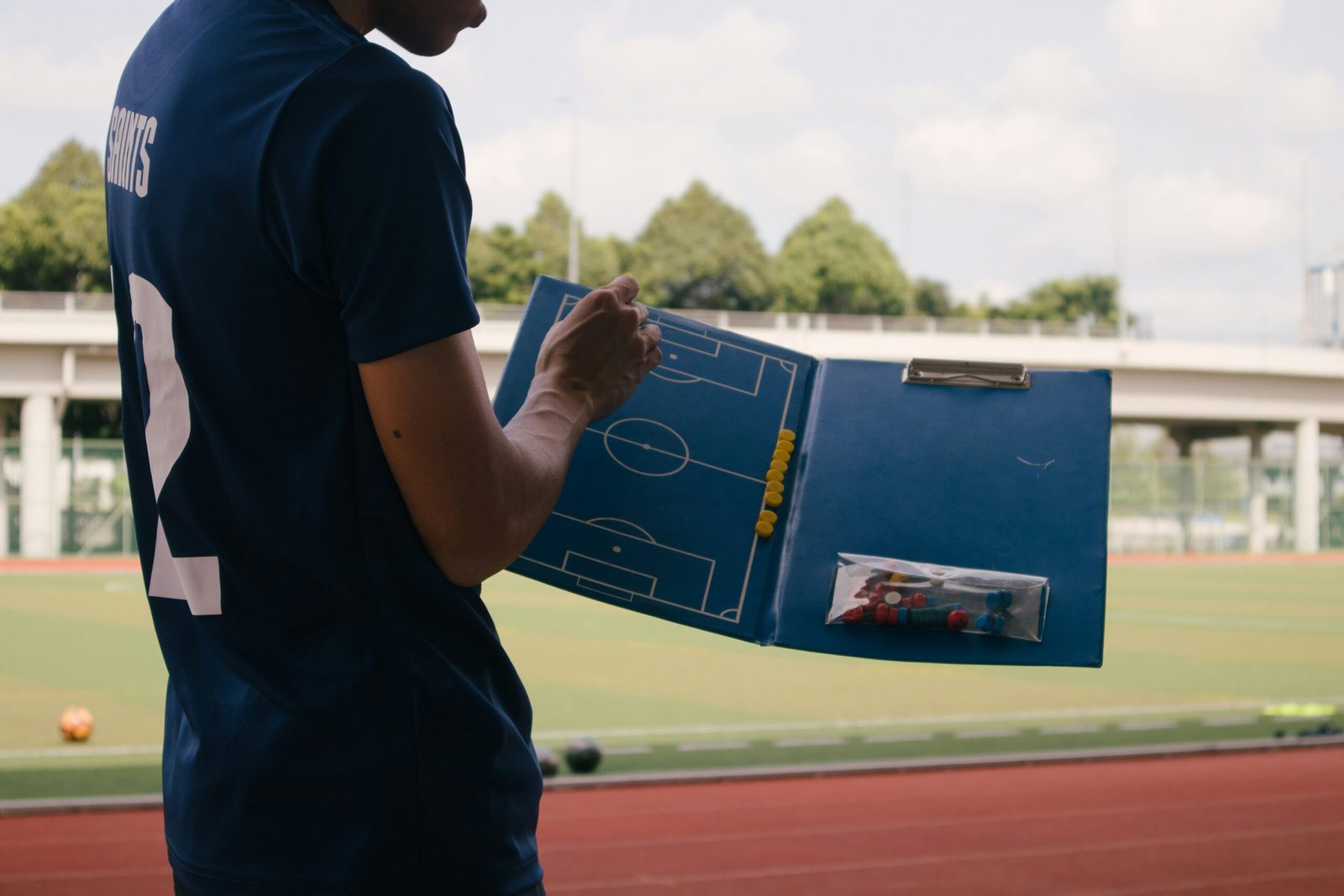
Comments are closed.